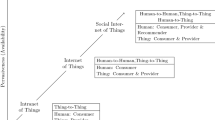Abstract
The Internet of Things (IoT) implies a new model and concept in the world of information and communication technology that the non-cooperation of some nodes in providing services to other nodes may result in the disconnection of some things with each other. Consequently, the proximity of such nodes is considerably reduced the network performance. In this paper, a multiphase method based on game theory and direct and indirect reputation has been designed to stimulate selfish and malicious nodes to cooperate in the Internet of Things, which starts with setting up nodes in the IoT network. In the first phase, nodes are grouped in clusters with cluster heads to collect data. Then, they play a dynamic and multi-person game when they promote their own data packet or others’ data packet in the second phase (multi-person game phase and data packet sending). The result of the game is applied to affect between nodes in the next phase. Nodes can pick their strategy when data packet forwarding in the third phase (direct and indirect reputation update). Nodes will update the neighboring node and the reputation table if they receive a confirmation message from the destination declaring that the data packet has a direct reputation. The results show that the accuracy of selfish node detection has increased by average of 8% and the false positive rate is 7% in comparison to comparative methods.










Similar content being viewed by others
References
Khanna A, Kaur S (2020) Internet of Things (IoT), applications and challenges: a comprehensive review. Wireless Pers Commun 114:1687–1762
Kumar S, Tiwari P, Zymbler M (2019) Internet of Things is a revolutionary approach for future technology enhancement: a review. J Big Data 6(1):1–21
Rawat P, Singh KD, Bonnin JM (2016) Cognitive radio for M2M and Internet of Things: a survey. Comput Commun 94:1–29
Aziz AA, Mamat MN, Salleh DM, Abdullah SFS, Nordin MN (2021) An analysis of systematic literature review on the development of Islamic oriented instruments. J Contemp Issues Bus Govern 27(1)
Balakrishnan K, Deng J, Varshney V (2005) TWOACK: preventing selfishness in mobile ad hoc networks. In: IEEE wireless communications and networking conference, vol 4. IEEE, pp 2137–2142
Guo J, Liu H, Dong J, Yang X (2007) HEAD: a hybrid mechanism to enforce node cooperation in mobile ad hoc networks. Tsinghua Sci Technol 12(S1):202–207
Chong Z-K, Tan S-W, Goi B-M, Ng BC-K (2013) Outwitting smart selfish nodes in wireless mesh networks. Int J Commun Syst 26(9):1163–1175
Manimaran A, Durairaj M (2016) The conjectural framework for detecting DDoS attack using enhanced entropy based threshold technique (EEB-TT) in cloud environment. Int J Adv Comput Res 6(27):230
Kaushik R, Singhai J (2011) Modspirite: a credit based solution to enforce node cooperation in an ad-hoc network. Int J Comput Sci Issues (IJCSI) 8(3):295
Rizwana G, Wasim G (2015) Enhanced intrusion detection & prevention mechanism for selfishness in MANET. Int J Innov Res Comput Commun Eng 3:10131–10138
Jesudoss A, Raja SK, Sulaiman A (2015) Stimulating truth-telling and cooperation among nodes in VANETs through payment and punishment scheme. Ad Hoc Netw 24:250–263
AbdelMohsen D, Abdelkader T (2015) Detecting selfish nodes and motivating cooperation in mobile ad-hoc networks. In: 2015 tenth international conference on computer engineering & systems (ICCES), IEEE, pp 301–306
Susan K, Konyeha C, John-Otumu A, Mughele E (2020) An improved token-based umpiring technique for detecting and eliminating selfish nodes in mobile ad-hoc networks. Egyptian Comput Sci J 44(2)
Bounouni M, Bouallouche-Medjkoune L (2018) Acknowledgment-based punishment and stimulation scheme for mobile ad hoc network. J Supercomput 74(10):5373–5398
Lupia A, Kerrache CA, De Rango F, Calafate CT, Cano J-C, Manzoni P (2017) TEEM: trust-based energy-efficient distributed monitoring for mobile ad-hoc networks. In: 2017 Wireless days, IEEE, pp 133–135
Kumar S, Dutta K, Sharma G (2016) A detailed survey on selfish node detection techniques for mobile ad hoc networks. In: 2016 Fourth international conference on parallel, distributed and grid computing (PDGC), IEEE, pp 122–127
Charilas DE, Panagopoulos AD (2010) A survey on game theory applications in wireless networks. Comput Netw 54(18):3421–3430
Al Sharah A, Alhaj M, Hassan M (2020) Selfish dynamic punishment scheme: misbehavior detection in MANETs using cooperative repeated game. IJCSNS 20(3):168–173
Abdalzaher MS, Seddik K, Elsabrouty M, Muta O, Furukawa H, Abdel-Rahman A (2016) Game theory meets wireless sensor networks security requirements and threats mitigation: a survey. Sensors 16(7):1003
Nobahary S, Garakani HG, Khademzadeh A, Rahmani AM (2019) Selfish node detection based on hierarchical game theory in IoT. EURASIP J Wirel Commun Netw 2019(1):1–19
Musthafa MM, Vanitha K, RAHMAN AMZ, Anitha K (2020) An efficient approach to identify selfish node in MANET. In: 2020 International conference on computer communication and informatics (ICCCI), IEEE, pp 1–3
Hasani H, Babaie S (2019) Selfish node detection in ad hoc networks based on fuzzy logic. Neural Comput Appl 31(10):6079–6090
Yao X, Wang J, Shen M, Kong H, Ning H (2019) An improved clustering algorithm and its application in IoT data analysis. Comput Netw 159:63–72
Author information
Authors and Affiliations
Corresponding author
Additional information
Publisher's Note
Springer Nature remains neutral with regard to jurisdictional claims in published maps and institutional affiliations.
Rights and permissions
Springer Nature or its licensor (e.g. a society or other partner) holds exclusive rights to this article under a publishing agreement with the author(s) or other rightsholder(s); author self-archiving of the accepted manuscript version of this article is solely governed by the terms of such publishing agreement and applicable law.
About this article
Cite this article
Abdi, G.H., Sheikhani, A.H.R., Kordrostami, S. et al. A novel selfish node detection based on reputation and game theory in Internet of Things. Computing 106, 81–107 (2024). https://doi.org/10.1007/s00607-023-01184-8
Received:
Accepted:
Published:
Issue Date:
DOI: https://doi.org/10.1007/s00607-023-01184-8




